Part 2: A Living Museum
Words and pictures: Ron Hewit
No one set out to turn the smithy into a time capsule, it just happened. From the calendar forever stuck at July 1970 and its picture of Harlech Castle to the anvil that sits in front of the forge, now shrugged in a hessian sack to protect it from rust; from the floor, part stone and part timber, to the horseshoes hanging high on beams in the roof, time stands still. However, the passing years have scratched deeply at the different surfaces. All the many horseshoes scattered around are crusty with age and the stone floor by the anvil is concave and rough, hollowed out by passing feet, while the anvil to my eyes sits far too low to the ground – it’s no wonder that Dad suffered from a sore back.
The rank of tools that used to sit in a row at the front of the forge are now pitted and ruined by rust. Once each had a particular role to play, whether it was a poker to move the hot coals around while the bellows were pumped, or tongs for turning hot metal in the fire or for transporting a white-hot length of steel back and forth from the fire to the anvil. Through daily use the handle of each was buffed to a smooth, dull, silvery gleam but now they look like scrap metal. A few years ago I went to look around the smithy with my dad and he picked up a few of those tools; seeing what had become of the things he’d once handled with such dexterity, he sighed sadly, sensing the ruinous power of time.
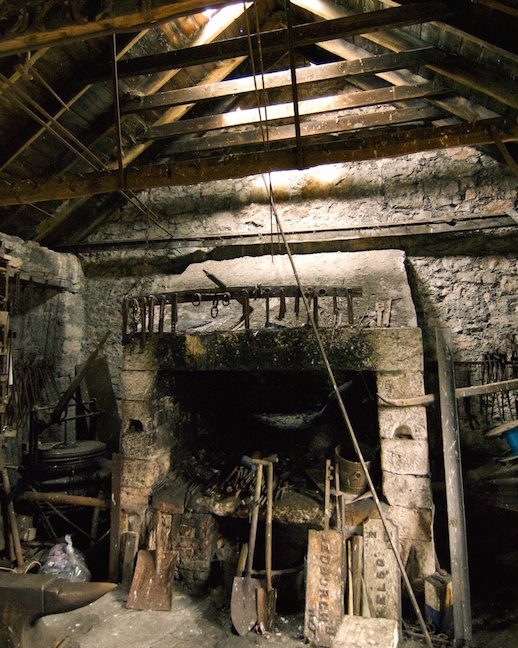 The forge, blackened by age
The forge, blackened by age
The stone-built forge dominates the interior of the smithy but now it sits blackened and cold. At one time there would have been two fires and two men working side by side at two anvils, but now there’s just one anvil and the ancient bellows either side of the forge are cracked and wheezy or silent. Clinker from thousands of fires is piled high to one side and to the back of the fireplace. Underneath the fire-blackened stones the metal basin that was once full of water where hot metal would be doused, crackling and steaming, now sits empty, broken and rusty.
Above the forge there’s a long wooden rack with forgotten and nameless tools hanging from it, put there for convenience, surely, but it’s decades since anyone laid a hand on them. If you half-close your eyes you can imagine the heat of the fire and hear the powerful thud of hammers on hot metal and the rhythmic ring of hammers on anvils; among the noise and industry the intense focus of craftsmen at work.
I’m making myths as I go. I remember my teenage years and back then craftsmanship was far from my thoughts. I’d be home from school and settled in front of the TV and it was always an imposition when Dad came to ask for my help. After my grandad retired, Dad worked for years on his own, but there were always jobs that needed two sets of hands and sometimes that meant me. I’d be given a sledgehammer and positioned on one side of the anvil opposite my dad and the forge and, under his direction, I would glumly hammer the red-hot metal thing he’d produced from the glowing coals as hard as I could while he turned and hammered it with more finesse, using his expert eye to judge when the job was done. Then I’d escape back to the TV as soon as possible. I look back now and hate my sulky self for the indifference I showed then. How I’d like to have that time again so I could work with my dad once more and try to do things better, with more enthusiasm and interest – hindsight at its worst.
Wherever I look I see objects from 40 years ago, but they have gathered such astonishing layers of dust it’s as if you can see the past. A hammer, rasp and a half-finished horseshoe that sit on a low table to the side of the anvil are coated with a thick, sooty grime; so too the workbench by the window, with its haphazard scattering of old tools, horseshoes and tins, its shelves bulging with long-forgotten paperwork, the little round alarm clock sitting in a wooden box, its hands frozen at 10 to 10.
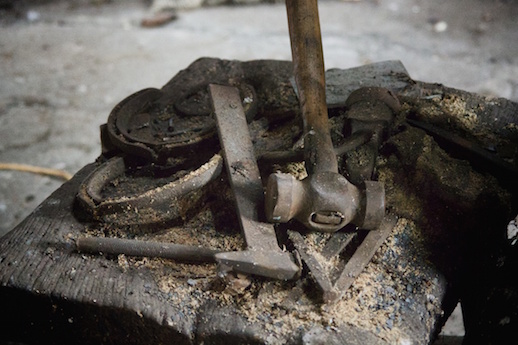 Tools and horseshoes on the low table beside the anvil
Tools and horseshoes on the low table beside the anvil
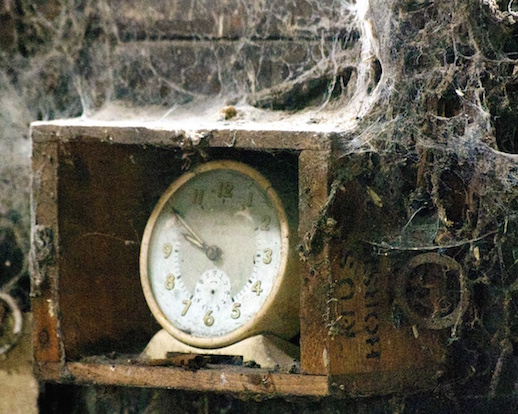 Forever 10 to 10
Forever 10 to 10
Thick cobwebs coat the many objects hanging from nails in the wall – scores of horseshoes, nuts and washers threaded through wire loops, bolts, pins and punches and things that defy description. I ask John if he knows their names or what they were used for and he’s almost as clueless as me. There’s an ancient drill that hangs above a vice on the bench, all long wooden levers, a counterweight and pivots, and we can’t fathom how it would have worked. We’re both thinking the same thing but not saying it – it’s too late to ask Dad now. I think even he would struggle to put a name to all the things in here, although I suspect my grandad could walk in and start work as if the past 80 years had never happened.
Looking around I see old overcoats hanging behind the double doors, untouched for who knows how long. On a shelf there is a pile of old school jotters in which Dad would write an account of the jobs he’d done each day, the smallest detail of what he’d made and for whom described in his fine rounded handwriting. (Later he would transfer that information to red leather ledgers, again writing it all by hand, a job for a Sunday afternoon, and later still he would sit with my mum at the kitchen table late into the night, reading out the details and prices of each job as my mum typed out invoices.)
Hanging on the wall there’s a framed certificate to mark my dad’s successful completion of a welding course, the year faded now and illegible. A huge, ancient lathe sits by the window in the back wall – so old that it was powered only by the strength of the poor apprentice nominated to climb to the perch in the roof and turn the massive wheel. The handle of one of the bellows is tipped with a cow’s horn. There are two little nooks carved into the stone either side of the forge. Racks of tools, ancient keys, paraffin lamps, cardboard boxes, lengths of chain, countless hammers, old pipe tobacco tins full of washers and other oddments… So much metal, so many things, all quietly ageing, a black hole of memories slowly collapsing into itself.
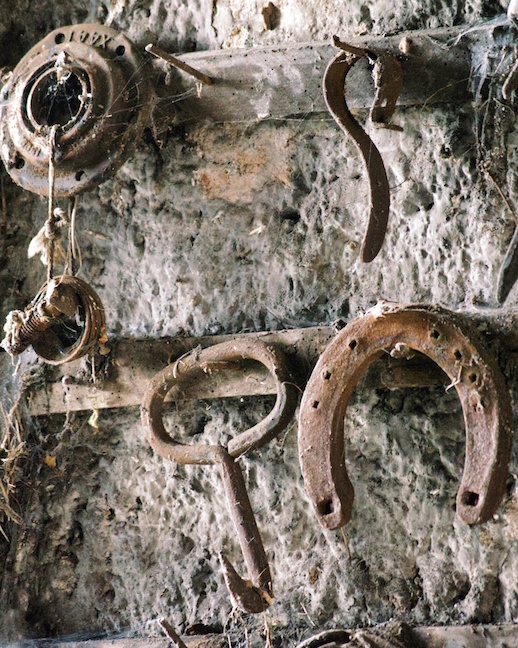 Ancient cobwebbed tools hanging from the walls
Ancient cobwebbed tools hanging from the walls
However, the time capsule lives. John has added new layers among the old – the metal gate that used to hang by the side of the house now leans against the workbench, and propped against the forge are the two arms of an old metal signpost that once stood at one end of the village (Kelso 2 miles, Jedburgh 8), broken now but rescued for a future restoration project, maybe soon or maybe never. Plastic bowls, oil drums, garden tools, paintbrushes, bicycles, newspapers, a pile of old dinner plates, the ready detritus of modern life, all quietly being absorbed, becoming part of family history.
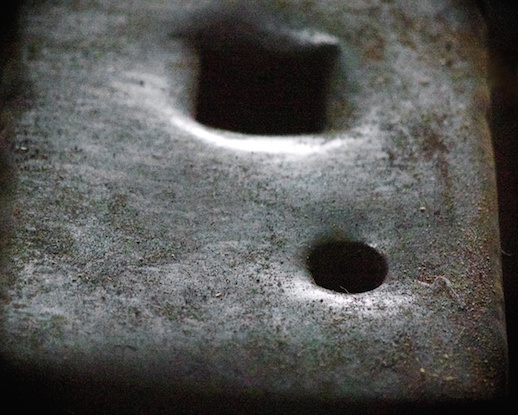 Dust coats the surface of the anvil
Dust coats the surface of the anvil
View the previous Last Blacksmith post here